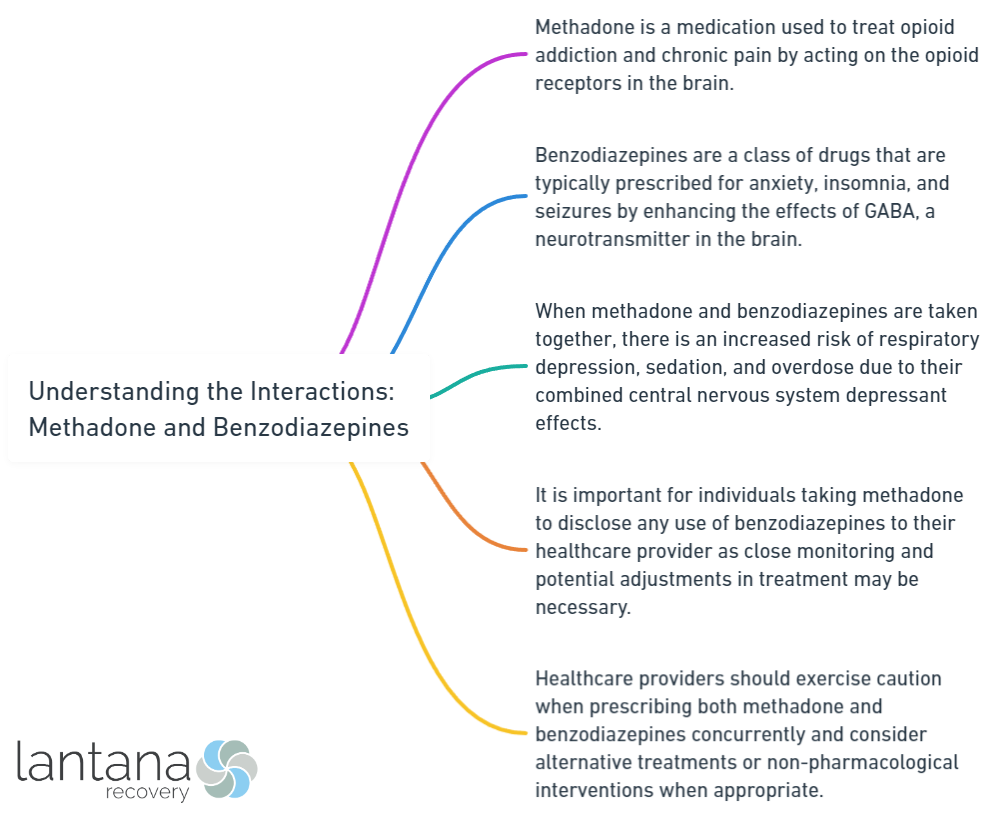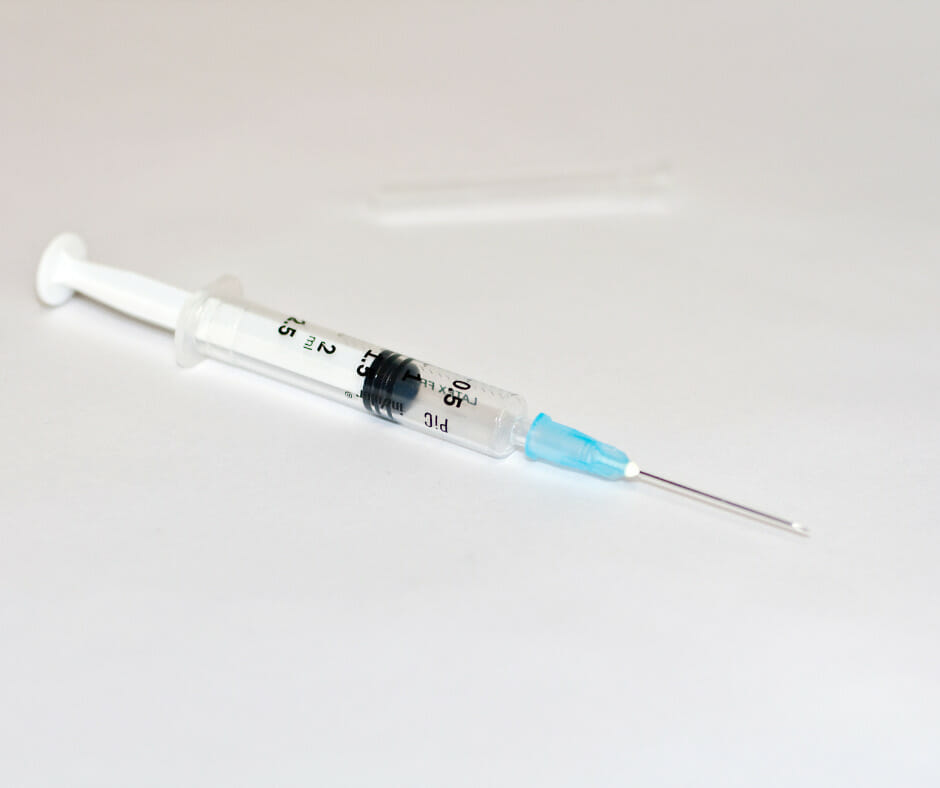Understanding the potential interactions between medications is crucial to ensure the safe and effective use of pharmaceuticals. In the case of methadone and benzodiazepines, a thorough understanding is particularly important. This article will provide an overview of methadone and benzodiazepines, explore the concerns related to their interaction, discuss the specific interactions between the two, highlight factors that influence these interactions, and address the associated risks and precautions. strategies for managing these interactions will be discussed.
Methadone is a medication primarily used in the treatment of opioid dependence and chronic pain. On the other hand, benzodiazepines are a class of medications commonly prescribed for their sedative, anxiolytic, and muscle relaxant properties. The combination of methadone and benzodiazepines can have potentially dangerous effects due to their overlapping mechanisms of action. Understanding these interactions is crucial to minimize the risk of adverse effects and optimize patient safety.
Specifically, the interaction between methadone and benzodiazepines can lead to increased sedation, respiratory depression, and an increased risk of overdose. Various factors influence the severity and likelihood of these interactions, including individual tolerance and sensitivity, the dose and administration of the medications, and the duration of their use.
It is important to be aware of the risks and precautions associated with the combination of methadone and benzodiazepines. These include an increased risk of overdose, impaired central nervous system functioning, and potential withdrawal symptoms when discontinuing the medications.
Managing these interactions involves effective communication with healthcare providers, gradual tapering and discontinuation of medications when appropriate, and consideration of alternative treatment options. By understanding the interactions between methadone and benzodiazepines and implementing appropriate management strategies, healthcare providers and patients can work together to ensure optimal therapeutic outcomes and minimize potential harm.

What is Methadone?
Methadone is a synthetic opioid used to treat opioid addiction and chronic pain.
What is Methadone and is it the same thing as meth? Well, it is taken orally and works by binding to the same brain receptors as heroin or oxycodone. Methadone differs from other opioids because it lasts longer, allowing for once-daily dosing and preventing withdrawal symptoms.
Methadone is an important part of medication-assisted treatment (MAT) for opioid addiction. When used as part of a comprehensive treatment plan, methadone can help individuals reduce or quit their illegal opioid use. Methadone maintenance treatment significantly reduces overdose deaths and improves social functioning.
It is important to use methadone under the guidance of a healthcare professional. The dosage and duration of treatment vary for each person based on their needs and how they respond to the medication. Regular monitoring and adjustment of the methadone dose may be necessary to maintain its effectiveness and safety.

What are Benzodiazepines?
Benzodiazepines – a class of medications widely used, but do we truly understand their nature? Delve with me into the world of benzodiazepines as we unravel their secrets. In this section, we’ll shed light on common medications within this class. Exploring their properties and effects, we’ll unlock the key to comprehending the complex interactions between benzodiazepines and other substances. Prepare to be enlightened as we journey into the realm of this intriguing pharmaceutical domain.
Common Medications in the Benzodiazepine class
Common medications in the benzodiazepine class, such as Alprazolam (Xanax), Diazepam (Valium), Lorazepam (Ativan), Clonazepam (Klonopin), and Chlordiazepoxide (Librium) are often prescribed to treat various conditions.
- Alprazolam (Xanax) is used to enhance the effects of the brain neurotransmitter GABA, thereby reducing anxiety and promoting relaxation in individuals suffering from anxiety and panic disorders.
- Diazepam (Valium) is another medication in this class, which provides short-term relief for anxiety disorders. Additionally, it can be utilized as a muscle relaxant and aid in alcohol withdrawal, and used in veterinary mental health.
- Lorazepam (Ativan) is beneficial for individuals dealing with anxiety and sleep problems. In some cases, it may also be used to manage seizures.
- Clonazepam (Klonopin) primarily calms the brain and nerves and is commonly prescribed for seizures and panic disorder.
- Chlordiazepoxide (Librium) effectively manages anxiety symptoms and assists in alcohol withdrawal. It can also act as a sedative for medical procedures.
It is important to note that these medications are generally prescribed for short-term use to minimize the risk of dependence and potential side effects. To ensure safe usage, it is crucial to follow the healthcare provider’s instructions and adhere to any tapering or discontinuation plans to minimize withdrawal symptoms.

Methadone and Benzodiazepines: Why the Concern?
Methadone and benzodiazepines can be dangerous when combined. Here are the reasons why:
1. Increased sedation: Both methadone and benzodiazepines are depressants of the central nervous system. When used together, they can enhance sedative effects, causing excessive drowsiness, confusion, and impaired coordination.
2. Respiratory suppression: Combining methadone, an opioid, with benzodiazepines can result in severe respiratory depression. Both substances act on the respiratory centers in the brain, potentially leading to shallow breathing or even respiratory arrest.
3. Overdose risk: “Methadone’s pharmacologic properties, such as its potential for overdose, QT interval prolongation, and interactions with other drugs, indicate a potential for serious or fatal side effects” (Methadone: A new old drug with promises and pitfalls, Trafton & Ramani, 2009.) Excessive amounts of methadone and benzodiazepines can cause overdose. The risk is greater when using them in combination, as the effects of each drug are intensified.
4. Impaired judgment: Using methadone and benzodiazepines together can impair judgment and cognitive function, increasing the risk of accidents, falls, and other risky behaviors.
5. Increased addiction potential: Methadone and benzodiazepines are both addictive. Using them together can enhance the risk of developing a substance use disorder or complicating existing addiction issues.
Interactions Between Methadone and Benzodiazepines
Interactions between methadone and benzodiazepines can have serious consequences. In this section, we’ll uncover the potential risks associated with this drug combination. From increased sedation and respiratory depression to enhanced central nervous system depression, the impacts of mixing methadone and benzodiazepines are profound. We’ll also explore the alarming risk of overdose that arises from this dangerous interaction. Brace yourself for a deep dive into the intertwined effects of these medications.
Increased Sedation and Respiratory Depression
Increased sedation and respiratory depression are significant concerns when methadone and benzodiazepines are combined. Taking methadone, a medication used for opioid addiction, with benzodiazepines, commonly prescribed for anxiety and insomnia, can lead to heightened sedation and respiratory depression. This combination can cause drowsiness, confusion, impaired coordination, and decreased oxygen levels in the body.
Due to the potential risks of increased sedation and respiratory depression, it is crucial to communicate with your healthcare provider for proper guidance and monitoring. They can help adjust dosages, create tapering plans, or explore alternative treatment options that may be safer for your specific situation. By following medical advice, you can ensure your well-being and minimize the risks associated with the combination of methadone and benzodiazepines.
Enhanced Central Nervous System Depression
Enhanced Central Nervous System Depression is a serious concern that arises when methadone and benzodiazepines are combined. This particular combination can amplify the depressive effects on the central nervous system, resulting in a heightened state of sedation and respiratory depression.
It is important to note that this combination also increases the risk of overdose, which can potentially lead to respiratory failure and even death. The severity of this interaction is influenced by various factors such as individual tolerance, sensitivity, dosage, administration, and duration of use.
To effectively manage these risks, it is crucial to maintain open communication with a healthcare provider. In some cases, gradual tapering or discontinuation of either one or both of the medications may be necessary. It is also crucial to consider exploring alternative treatment options if the risks outweigh the benefits in order to prioritize the well-being of the patient and minimize the chances of Enhanced Central Nervous System Depression.
Risk of Overdose
The combination of methadone and benzodiazepines carries a significant risk of overdose. Taking both medications together can result in increased sedation and respiratory depression, which can lead to a life-threatening overdose. The risk is particularly high when higher doses of both drugs are involved.
Additionally, individual tolerance and sensitivity to these medications also contribute to the risk of overdose. To reduce the risk, healthcare providers should closely monitor patients who are prescribed both methadone and benzodiazepines. It is important for patients to maintain open communication with their healthcare providers regarding any concerns or symptoms they may have.
Following their healthcare provider’s instructions and adjusting medication doses if necessary is crucial in mitigating the risk of overdose. In certain cases, alternative treatment options with institutions like Lantana Recovery in Greenville may be considered to avoid these risks. Prioritizing safety and seeking medical advice for any concerns or questions about the medications should be a top priority.

Factors That Influence the Interaction
In this section, we uncover the key elements that play a role in the interaction between methadone and benzodiazepines. From individual tolerance and sensitivity to the dose and administration methods and the duration of use, we delve into the factors that shape this complex interplay. Exploring these factors will shed light on the intricate dynamics and potential consequences of combining these substances. So, let’s analyze the ingredients that make this interaction uniquely significant.
Individual Tolerance and Sensitivity
Individual tolerance and sensitivity are crucial factors to consider in the interaction between methadone and benzodiazepines. It is important to recognize that different individuals may respond differently, with some being more susceptible to the sedative effects.
Individuals with lower tolerance or heightened sensitivity are at a greater risk of experiencing excessive sedation and respiratory depression. It may be necessary to adjust the dosage based on each individual’s tolerance and sensitivity, as lower doses could potentially reduce adverse effects.
Regular monitoring is essential in order to evaluate tolerance levels and make any necessary adjustments to minimize potential risks.
Dose and Administration
When it comes to methadone and benzodiazepines, the careful monitoring and adjustment of dose and administration are crucial in determining potential risks and outcomes. Taking into consideration these factors ensures the safe and effective use of both medications.
The dose of methadone and benzodiazepines should be carefully monitored and adjusted based on individual needs and responses. It is important to consider that higher doses can increase the risk of sedation, respiratory depression, and overdose.
Frequent or high-frequency administration of benzodiazepines can potentiate the effects of methadone, increasing the risk of central nervous system depression and respiratory distress.
The route of administration can affect the speed and intensity of drug interactions. For example, intravenous administration of benzodiazepines can result in rapid effects and increased risks compared to oral administration.
The timing of dose administration is crucial to avoid overlapping peak effects of both medications. Close monitoring and appropriate timing can help prevent excessive sedation and respiratory depression.
Effective management of methadone and benzodiazepines requires clear communication with a healthcare provider. They can provide guidance on appropriate dosages, monitor for potential interactions, and make adjustments based on individual needs. Gradual tapering and discontinuation of benzodiazepines may be recommended to minimize risks. Alternative treatment options can also be explored to reduce reliance on these medications.
Duration of Use
The duration of use is a crucial factor to consider when discussing the interactions between methadone and benzodiazepines. It refers to the length of time that an individual has been using these medications.
Understanding the duration of use is vital because it directly correlates with the risks and complications associated with this interaction. The longer someone has been using methadone and benzodiazepines, the higher the likelihood of experiencing adverse effects.
Research suggests that prolonged use of these medications can elevate the risk of overdose, impairment of the central nervous system, and withdrawal symptoms. Over time, the body may become more sensitive to these drugs, resulting in increased sedation, respiratory depression, and even potentially life-threatening consequences.
To minimize these risks, healthcare providers should carefully monitor individuals who have been using methadone and benzodiazepines for an extended period. They may also consider alternative treatment options or gradually tapering off and discontinuing these medications.
It is crucial for individuals using these medications to openly communicate with their healthcare providers about the duration of use. This information will assist in developing appropriate treatment plans and effectively managing any potential complications.
Risks and Precautions
Researchers Lintzeris, PhD and Nielson, PhD conclude in Benzodiazepines, Methadone, adn Buprenorphine that individuals who are not undergoing treatment for heroin addiction frequently utilize benzodiazepines (BZDs), along with patients who are undergoing methadone and buprenorphine (BPN) treatment. Understanding the potential dangers and precautions associated with the interaction between methadone and benzodiazepines is crucial. We’ll explore the risks involved, the potential for increased overdose risk, the impact on the central nervous system, and the withdrawal symptoms that may arise. It’s important to be aware of these factors to ensure safety and informed decision-making when it comes to the concurrent use of these medications.
Increased Risk of Overdose
The combination of methadone and benzodiazepines significantly increases the risk of overdose. When these substances are taken together, their sedative and respiratory depressant properties are intensified, creating a highly dangerous and potentially life-threatening situation.
- Both high and low doses of methadone or benzodiazepines contribute to the risk of overdose when used in combination. The individual’s tolerance and sensitivity to these substances also play a role in increasing the risk. Factors such as age, overall health, and previous substance use influence how someone responds to methadone and benzodiazepines. Therefore, healthcare providers must carefully assess and monitor patients who are using these medications concurrently.
- To effectively manage the increased risk of overdose, open communication with a healthcare provider is essential. They can offer guidance on appropriate dosing and administration, as well as monitor for signs of overdose or adverse reactions. In some cases, gradual tapering and discontinuation of either one or both medications may be necessary to reduce the risk.
- For individuals at high risk, it is important to consider alternative treatment options. Non-pharmacological interventions, such as therapy and counseling, can address underlying issues and decrease reliance on high-risk medications.
Recognizing and understanding the heightened risk of overdose when methadone and benzodiazepines are combined is crucial. By taking appropriate precautions and closely collaborating with healthcare providers, it is possible to minimize harm and prioritize patient safety.
Central Nervous System Impairment
Central Nervous System Impairment is a significant concern when methadone and benzodiazepines are used together. The combination of these substances can have serious consequences.
- The Central Nervous System, which regulates vital functions such as breathing, heart rate, and consciousness, is susceptible to impairment. Such impairment can have a detrimental effect on overall health.
- When methadone and benzodiazepines are used in conjunction, they amplify the depressive effects on the Central Nervous System. This can lead to slowed breathing, decreased heart rate, and extreme drowsiness.
- The risk of overdose significantly increases when these substances are combined. The Central Nervous System can be overwhelmed, resulting in a dangerous level of drug concentration in the body.
- Several factors influence this interaction, including individual tolerance and sensitivity to the drugs, the dose and administration of each substance, and the duration of use.
- The combination of methadone and benzodiazepines can cause symptoms such as confusion, difficulty concentrating, dizziness, and coordination problems, all of which stem from Central Nervous System Impairment.
To prevent Central Nervous System Impairment, it is crucial to communicate with healthcare providers regarding all medications being taken. Gradual tapering and discontinuation of one or both drugs may be necessary. In some cases, alternative treatment options may need to be explored.
Withdrawal Symptoms
Withdrawal symptoms can occur when an individual abruptly stops taking methadone or benzodiazepines. These symptoms, which can be uncomfortable and distressing, need to be managed and understood.
1. Physical symptoms: Withdrawal from methadone or benzodiazepines can lead to various physical symptoms, such as nausea, vomiting, sweating, tremors, muscle aches, and an increased heart rate. These symptoms can be intense and may persist for days or even weeks.
2. Psychological symptoms: Apart from the physical symptoms, withdrawal can also result in psychological symptoms like anxiety, irritability, restlessness, insomnia, and mood swings. To effectively handle these symptoms, it is recommended to seek support from healthcare providers or addiction specialists.
3. Severity of symptoms: The severity of withdrawal symptoms varies based on factors like the duration of use, dosage, and individual tolerance. While some individuals may experience mild symptoms, others may face more severe manifestations. It is important to work closely with healthcare providers to create a personalized plan for managing these symptoms effectively.
4. Managing withdrawal symptoms: Gradual tapering and discontinuation of methadone or benzodiazepines, under the guidance of a healthcare provider, is commonly the preferred approach to minimize withdrawal symptoms. It is crucial to consider alternative treatment options based on individual needs and goals.
Withdrawal symptoms associated with methadone or benzodiazepines can be challenging, but seeking support from healthcare professionals and following a personalized plan can increase the likelihood of successful recovery.
Managing Interactions between Methadone and Benzodiazepines
When it comes to managing interactions between methadone and benzodiazepines, effective communication with your healthcare provider is key. Alongside that, understanding the benefits of gradual tapering and discontinuation as well as exploring alternative treatment options can greatly enhance your journey towards a healthier and safer approach to medication. So let’s dive into these essential aspects and discover ways to navigate this complex interplay between methadone and benzodiazepines.
Communication with Healthcare Provider
In A Review of Methadone Deaths in Jefferson County, Alabama by Mikolaenko, MD et al., the research findings indicated that the intricate interplay between benzodiazepines and methadone impacts methadone levels, wherein acute intoxication leads to receptor competition and prolonged misuse potentially hinders methadone metabolism. Effective communication with your healthcare provider is crucial when it comes to managing interactions between methadone and benzodiazepines. It is important to maintain an open and honest dialogue throughout your treatment journey. Here are some key points to consider when communicating with your healthcare provider:
1. Be sure to share your complete medical history, including any substance use disorders, mental health conditions, and relevant medical information. By doing so, you are helping your healthcare provider make informed decisions about your treatment.
2. Inform your healthcare provider about all the medications you are currently taking, including over-the-counter drugs, supplements, and herbal remedies. This will enable them to identify any potential interactions and make necessary adjustments to your treatment plan.
3. Don’t hesitate to discuss any concerns or side effects you may be experiencing with your healthcare provider. It is important to report any unusual symptoms or side effects promptly, as this allows for appropriate changes to your medication regimen if needed.
4. Always follow the prescribed dosages and instructions given to you by your healthcare provider. Deviating from these without proper consultation can increase the risk of adverse reactions and complications.
5. Stay proactive in updating your healthcare provider about any changes in your health status or lifestyle. This includes informing them about any new medications, mental health changes, or major life events that may have an impact on your treatment.
Remember, effective communication with your healthcare provider is the key to a safe and successful treatment plan. By working together, you can address concerns, manage interactions, and optimize your overall well-being.
Gradual Tapering and Discontinuation
Gradual tapering and discontinuation are crucial for managing interactions between methadone and benzodiazepines. Slowly reducing the dosage of both medications under healthcare provider guidance minimizes withdrawal symptoms and potential risks. Abruptly stopping either medication can lead to unpleasant withdrawal symptoms and increase the risk of relapse or other adverse effects.
Throughout the tapering process, the healthcare provider closely monitors the patient’s progress and adjusts the dosage accordingly. The duration of tapering varies depending on individual factors, such as medication use duration, dosage, and overall health status. The goal is to gradually decrease the dosage of both medications until they can be safely discontinued.
Open communication with the healthcare provider is essential for patients during the tapering process. Any concerns or difficulties experienced should be reported, as adjustments to the tapering schedule may be necessary. The healthcare provider also offers support and guidance to manage withdrawal symptoms that may arise.
By following a carefully planned tapering and discontinuation schedule, individuals can safely transition off methadone and benzodiazepines. This process allows the body to adjust gradually and minimizes the risk of withdrawal symptoms and complications.
Fact: Gradual tapering and discontinuation of methadone and benzodiazepines is important for the safety and well-being of individuals using these medications. It allows the body to adjust slowly and decreases the risk of withdrawal symptoms or adverse effects.
Alternative Treatment Options
When it comes to managing the interactions between methadone and benzodiazepines, there are several alternative treatment options to consider. These options include:
1. Medication adjustment: One strategy is to replace one or both drugs with non-addictive medications for anxiety or pain management.
2. Cognitive-behavioral therapy: Another option is to manage anxiety or pain without relying solely on medication. This can be done by changing negative thought patterns and developing coping mechanisms through therapy.
3. Support groups: Joining a support group or attending counseling sessions can provide a safe space to share experiences, gain support, and learn from others who have successfully managed their medication interactions.
4. Alternative therapies: Some individuals may find relief through alternative therapies such as acupuncture, yoga, or meditation. These practices can promote relaxation, reduce anxiety, and alleviate pain.
5. Lifestyle changes: Adopting a healthy lifestyle that includes regular exercise, proper nutrition, stress management techniques, and adequate sleep can improve overall well-being and potentially reduce the need for medication.
It is important to note that the most suitable approach may vary depending on individual needs and circumstances. Consulting with a healthcare provider is crucial for determining the best course of action.
Frequently Asked Questions
Can methadone and benzodiazepines be safely taken together?
No, it is not safe to take methadone and benzodiazepines together. The combination of these drugs can lead to severe central nervous system depression, including respiratory depression, which can be life-threatening.
What are the dangers of mixing methadone and benzodiazepines?
Mixing methadone and benzodiazepines can result in dangerous interactions that depress the central nervous system, leading to difficulty breathing, respiratory arrest, coma, and even death. This combination can also increase the risk of addiction.
Can benzodiazepines be used in medically assisted detox programs?
In some cases, benzodiazepines may be used in medically assisted detox programs under the supervision of a healthcare professional. However, precautions need to be taken due to the dangerous interactions and increased risk of respiratory depression when combined with methadone.
What are some typical uses of benzodiazepines?
Benzodiazepines are commonly prescribed to manage anxiety, insomnia, alcohol withdrawal, and seizures. They have a sedative effect and work by slowing down the central nervous system.
What are the dangers of methadone and benzodiazepine abuse?
Methadone and benzodiazepine abuse can lead to addiction and adverse effects on the central nervous system. The combination of these drugs can be particularly dangerous, increasing the risk of respiratory depression, coma, and death.
How can I seek treatment for opioid or benzodiazepine abuse?
If you or someone you know is struggling with opioid or benzodiazepine abuse, it is essential to seek professional help. Treatment centers like Lantana Recovery offer specialized programs for opioid and benzodiazepine addiction, including medication-assisted treatment and psychotherapy programs.









